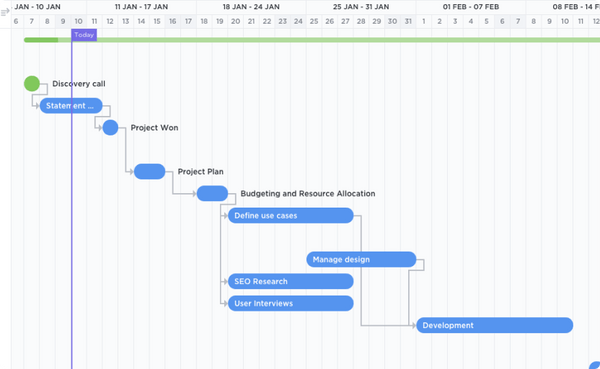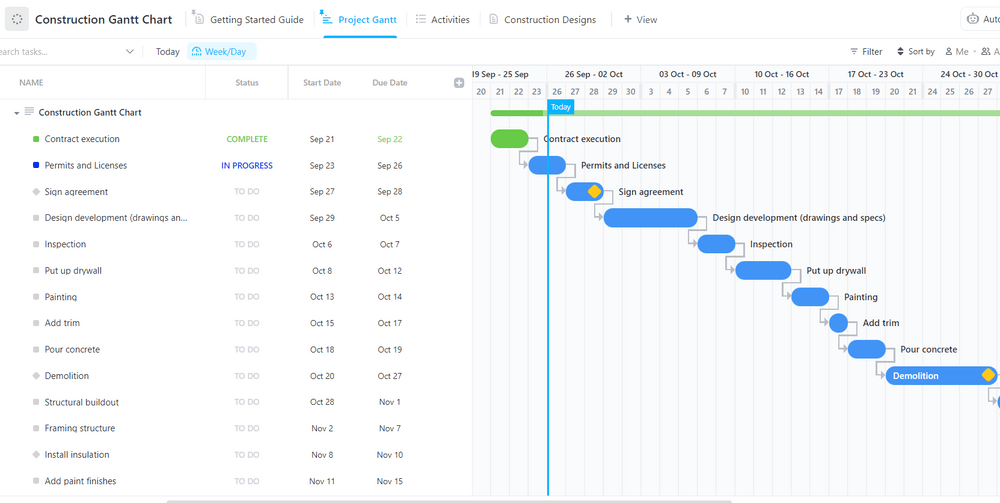بصفتك مدير مشروع، فإن فهم المخطط العام والجدول الزمني لمشاريعك هو مفتاح نجاحك. وهنا يأتي دور مخططات جانت. توفر لك هذه الأدوات المرئية القيمة نظرة عامة شاملة على الجدول الزمني للمشروع، مما يتيح لك التخطيط الفعال لسير العمل وتخصيص الموارد وتتبع التقدم المحرز.
ومع ذلك، قد تبدو صياغة مخطط جانت المثالي بمثابة عقبة إذا كنت جديدًا في هذه اللعبة.
لمساعدتك، قمنا بتنسيق قائمة تضم 20 مثالاً لمخطط جانت البياني تغطي مشاريع وصناعات مختلفة. ولجعل الأمور أكثر إثارة للاهتمام، قمنا بنسج رؤى لا تقدر بثمن لمساعدتك في تسخير قوة مخططات جانت لتلبية احتياجات إدارة المشروع.
لذا، استعد بينما نستكشف أمثلة مختلفة لمخططات جانت البيانية ونرى كيف يمكن أن تساعد في إنشاء استراتيجية شفافة ومنظمة لإدارة المشاريع.
ما هو مخطط جانت؟
A مخطط جانت التقليدي ، في لمحة، يمكن أن يكون مخيفًا.
هل هو مخطط شريطي أفقي بخطوط؟ أمخطط شريطي شريطي مكدس مع الوقت؟
بشكل أساسي، مخطط جانت هو مخطط جدول زمني بسيط للمشروع على شكل مخطط شريطي. يعرض الجزء العلوي الإطار الزمني، ويسرد الجانب الأيسر من المخطط مهام المشروع وأنشطته.
تحقق من مقال حول مخططات جانت مقابل الجداول الزمنية إذا كنت تريد معرفة الفروق
الغرض من مخطط جانت هو مساعدتك:
- في تخطيط المشروع وجدولة المهام
- تخطيط العمل في سباقات السرعة
- تصور كيفية تطور المشاريع والمهام المتعددة مع مرور الوقت
- تعاون مع فريقك وتعيين المهام
- مقارنة الجدول الزمني المخطط له بالجدول الزمني الفعلي
- تتبع الموارد وإدارتها,المعالموالتبعيات يمكنك رسم كل مهمة أو حدث أو نتيجة أو تقدم في مشروعك على هذا المخطط الشريطي الأفقي.
من يمكنه الاستفادة أكثر من مخططات جانت؟
مخططات جانت هي أدوات فعالة من أجل مديري المشاريع وموظفي الموارد البشرية، وقادة الفرق، والرؤساء التنفيذيين، ومديري التكنولوجيا، والاستشاريين، والمديرين العامين، وفرق التسويق، وما إلى ذلك.
بصراحة، أي شخص يريد صورة فورية عن الجدول الزمني للمشروع يمكن أن يستفيد من مخطط جانت
مكونات مخطط جانت ### مكونات مخطط جانت
تعرض مخططات جانت البيانية بشكل أساسي جميع مهام مشروعك مع جداولها الزمنية باستخدام محورين. فيما يلي تفصيل للأجزاء المختلفة لمخطط جانت البياني. تظل هذه المكونات ثابتة، بغض النظر عن الغرض الذي تستخدم مخطط جانت من أجله.
- قائمة المهام: يتم عرض قائمة رأسية بجميع المهام على الجانب الأيسر من مخطط جانت. وغالبًا ما يتم ترميز المهام بالألوان، مما يجعل التنقل بينها أكثر بساطة
- الخط الزمني: يمثل هذا الإطار الزمني الذي يغطي مخطط جانت الخاص بك. اعتمادًا على مدى تعقيد المشروع ومستوى التفاصيل المطلوبة، يمكن أن يعرض أيامًا أو أسابيع أو شهورًا أو حتى سنوات
- الأشرطة: تمثل الأشرطة الأفقية بصريًا المهام ومدتها والتقدم المحرز فيها. يوفر طول كل شريط نظرة عامة سريعة على المدة التي ستستغرقها المهمة. مع تقدم المهام، تصبح الأشرطة مظللة بشكل متزايد
- أسهم: تشير الأسهم إلى تبعيات المهام وتشير إلى التسلسل الذي يجب إكمال مهام محددة فيه
- علامات معالم : يتم تمثيلها على شكل ماسات، وهي تشير إلى المعالم الرئيسية أو النقاط الحرجة في المشروع، مثل إكمال المراحل الرئيسية
- المكلفون: في العديد من أدوات إدارة المشاريع، سترى صورة صغيرة أو الأحرف الأولى من اسم الشخص المكلّف بمهمة ما معروضة بالقرب من شريط المهام، مما يجعل تخصيص الموارد وإدارة عبء العمل أكثر شفافية
- خط التاريخ: خط عمودي يسلط الضوء على التاريخ الحالي، مما يساعدك على تحديد المهام القادمة والمواعيد النهائية بسهولة
- شريط التقدم: يقع هذا الشريط الأفقي بين الخط الزمني وأشرطة المهام، ويتتبع هذا الشريط الأفقي التقدم الإجمالي للمشروع
- المسار الحرج: أطول تسلسل من المهام التي يجب إكمالها حتى يتم تنفيذ المشروع بنجاح
اقرأ أيضًا: كيفية إنشاء مخطط جانت
20 مثال على مخطط جانت البياني
فيما يلي 20 طريقة يمكنك من خلالها استخدام مخططات جانت لإدارة المشاريع لمختلف حالات الاستخدام.
1. مثال على مخطط جانت البياني لإدارة المشاريع
تُعد مخططات جانت ضرورية لجميع أنواع إدارة المشاريع . يمكن أن يكون مرئيًا مفيدًا يتيح لك تقسيم خطة المشروع والأنشطة اليومية
يمكنك ذلك
- تخطيط ترتيب المهام
- التخطيطالجداول الزمنية لإدارة المشروع
- وضع جدول زمني للمشروع
- تعيين مهام متعددة وإدارة الموارد
- رسم بياني لتبعيات المهام
ونظرًا لأنه يتم رسم كل شيء على الرسم البياني مباشرةً، لا فريقك ولا يحتاج العملاء أن يطلبوا منك تحديثات المشروع .
استخدم ميزات السحب والإفلات في قالب مخطط جانت البسيط من ClickUp لإعادة تعيين المهام وفهم كيفية ارتباط المهام بالأهداف والتبعيات
قالب مخطط جانت البياني البسيط لإدارة المشاريع في ClickUp عبارة عن أداة مرئية تساعد مديري المشاريع وفرق العمل على تتبع الجداول الزمنية والمهام والتبعيات الخاصة بالمشروع.
يوفر هذا القالب واجهة سهلة الاستخدام تتيح للمستخدمين إنشاء المهام وتعيينها لأعضاء الفريق وتحديد الأولويات وإضافة التبعيات. كما يمكن للمستخدمين أيضًا تعديل الجداول الزمنية والموارد حسب الضرورة، مع توفير تحديثات وتنبيهات في الوقت الفعلي لإبقاء الجميع على نفس الصفحة. قم بتنزيل هذا القالب
2. مثال على مخطط جانت الإنشائي
"سيكون الحمام جاهزاً خلال أسبوع."
"سيبدأ البناء خلال 3 أسابيع."
لقد سمعنا جميعاً مدير الموقع أو المهندس يقول ذلك.
وبصفتك مدير مشروع بناء، إذا كانت هذه الردود تجعلك تسخر، فأنت تعلم مشاريع البناء غالبًا لا تفي بالمواعيد النهائية.
لحسن الحظ، يُعد مخطط جانت البسيط مثاليًا لـ الحفاظ على مشاريع البناء في الموعد المحدد والتأكد من أن أعضاء طاقم العمل والعملاء والمقاولين من الباطن على اطلاع على كل ما يتعلق بالمشروع.
فقط اسأل جينيفر فولبريشت، مديرة مشروع معتمدة من PMP ومستشارة رئيسية في JVC "نحن نستخدم مخططات جانت لتسليط الضوء على المهام الحرجة ونستخدم تطلعًا مستقبليًا مدته ثلاثة أسابيع للإبلاغ عن المعالم القادمة في مشاريعنا الإنشائية . تعد مخططات جانت طريقة رائعة لتصور العديد من الأجزاء والقطع المتحركة أثناء البناء.
أرسل مخطط جانت إلى كل من أصحاب المصلحة في المشروع قبل بضعة أيام من اجتماع الحالة حتى يتسنى مراجعتها، ويأتي الجميع إلى الاجتماع وهم مستعدون لمناقشة أنشطتهم القادمة."
تأكد من أن الجميع على نفس الصفحة باستخدام مخطط جانت الإنشائي البسيط هذا لتتبع المراحل الرئيسية وتسليم المشاريع في الوقت المحدد
تحقق من قالب مخطط جانت البياني الإنشائي الخاص ب ClickUp لمشروعك الإنشائي التالي. قم بتنزيل هذا القالب
3. مثال على مخطط جانت للموارد البشرية
استعراض أكوام من السير الذاتية، والتعامل مع عملية التأهيل، وتحديث السياسات, تبسيط عمليات المقابلات الشخصية ... العمل في الموارد البشرية ليس بالمهمة السهلة.
ومع ذلك، مع وجود مخططات جانت تحت تصرفك، ستتمكن من التعامل مع معظم الموارد البشرية المهام بكل سهولة.
استخدمه لـ
- تتبع مدى تقدم المتقدمين في عملية التوظيف
- تتبعمؤشرات الأداء الرئيسية للموارد البشرية
- جدولة المقابلات
- تتبع التحديثات والمشكلات الحالية للموظفين
- إدارة عمليات التأهيل
- تجاهل نكات الموارد البشرية (لأننا نعلم أنك تفكر في المزيد منها أثناء قراءة هذا المقال)
اصنع مخطط جانت لإدارة الموارد البشرية الخاص بك على ClickUp! ابدأ بـ قوالب للموارد البشرية .
المكافأة: قوالب تسوية الموارد !
4. خطة العمل مثال على مخطط جانت
فعال إدارة الأعمال يحتاج إلى خطة متقنة للغاية.
هناك وصف للشركة وتحليل للسوق تحليل تنافسي والتوقعات المالية، وغير ذلك الكثير.
من الواضح أنها تنطوي على الكثير من المعلومات التي يمكن أن تصبح بسرعة مربكة لك وللمستثمرين المحتملين.
_دعنا لا داعي للذعر. دعنا نتصور
باستخدام مخطط جانت، يمكنك بشكل استراتيجي:
- جدولة المشاريع والمهام
- إدارة الموارد
- تعيين المراحل الرئيسية لتحديد المنجزات الرئيسية
بهذه الطريقة، يمكنك إنشاء خارطة طريق مناسبة للأعمال. خريطة تجعلك تشعر بالثقة بشأن نمو مشروعك وتساعد مستثمريك على تصور كل التفاصيل.
قم بالإشراف على جميع الموارد الحالية والقادمة اللازمة لتطوير أعمال جديدة باستخدام نموذج تخطيط سعة الحساب من ClickUp
استخدم قالب مخطط جانت البياني لتخطيط حساب الأعمال ClickUp لتتبع المشاريع وإعداد المهام مع المواعيد النهائية. يتيح لك هذا القالب تحديد الاختناقات والتأكد من أن مشروعك يسير على المسار الصحيح. قم بتنزيل هذا النموذج
5. مثال على مخطط جانت التسويقي
_هل أنت مسوق تنهي مهامك باستمرار لتجد المزيد من المهام في قائمة مهامك؟
أنت بحاجة إلى مخططات جانت.
استخدمها للتخطيط الحملات التسويقية ، تصور استراتيجيتك، قم بتعيين أهداف التسويق والمعالم، وما إلى ذلك، ولاحظ مقدار الوقت الذي يمكنك توفيره في التخطيط.
ينتهي بك الأمر أيضًا إلى توفير الوقت في التواصل من خلال مشاركة مخطط جانت لفريقك وأصحاب المصلحة لتتبع تقدم الهدف.
_أفضل جزء؟
يمكنك أنت وفريقك التخطيط بشكل مستمر منذ أدوات إدارة المشاريع التسويقية مثل ClickUp تقدم مخططات جانت التفاعلية التي يتم تحديثها في الوقت الفعلي.
إليك مثالاً على ذلك:

عبر فريق الشرائح
6. مثال على مخطط جانت لإدارة المنتجات
تشبه خرائط طريق المنتج ومخططات جانت مخططات جانت أيام الأحد والفطور المتأخر. تناسب مثالي، بدون الميموزا. (هذا من أجل حفلة الإطلاق!)
ومع مخطط جانت، لا يوجد مكان أفضل من مخطط جانت لتخطيط تطوير المنتج وإطلاقه وتصنيعه .
يمكنك تتبع:
- البحث
- ميزانيات المشاريع
- تطوير المنتجات الرشيقة التقدم
- الأعمال المتراكمة للمنتج
- تواريخ الإصدار
يعد مخطط جانت نعمة حقيقية لمشروع معقد يعتمد على فرق وأقسام متعددة.
إليك مثال على خارطة طريق إطلاق المنتج:
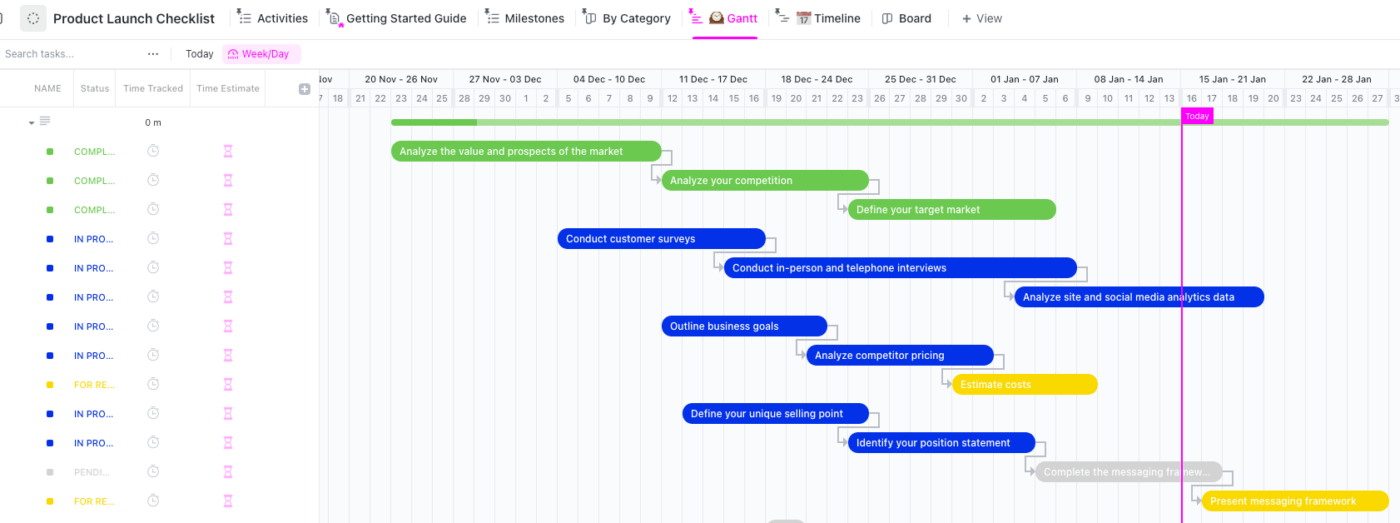
عبر ClickUp
قالب قالب قائمة مراجعة إطلاق المنتج من إعداد ClickUp يبقي جميع أنشطتك ومعالمك على المسار الصحيح لخطة إطلاق منتج فعالة. استخدم مخطط جانت هذا لمراقبة كل مرحلة من مراحل عملية تطوير منتجك. قم بتنزيل هذا النموذج
7. مثال على مخطط جانت للوسائط
_أضواء، كاميرا، جانت!
نعم، حتى الفرق الإعلامية يمكن أن تستفيد من مخططات جانت.
يمكنك بسهولة:
- جدولة جلسات العصف الذهني لمحتوى الفيديو الخاص بك
- تعيين مهام ما قبل الإنتاج والإنتاج وما بعد الإنتاج
- تخطيط وتحديد تواريخ الإصدار
- إنشاء جدول زمني لكل المحتوى الذي تحتاج إلى نشره في أسبوع أو شهر
- تتبع التقدم المحرز من قبل الأقسام مثل الموسيقى، واختيار الممثلين، والكتابة,تحرير الفيديوإلخ.
سواء أكان مقطع فيديو على YouTube أو فيلمًا سينمائيًا، يمكن أن يساعدك مخطط جانت البسيط في تقديم محتوى رائع.
إليك مثال بسيط لمخطط جانت لإنتاج الفيديو:
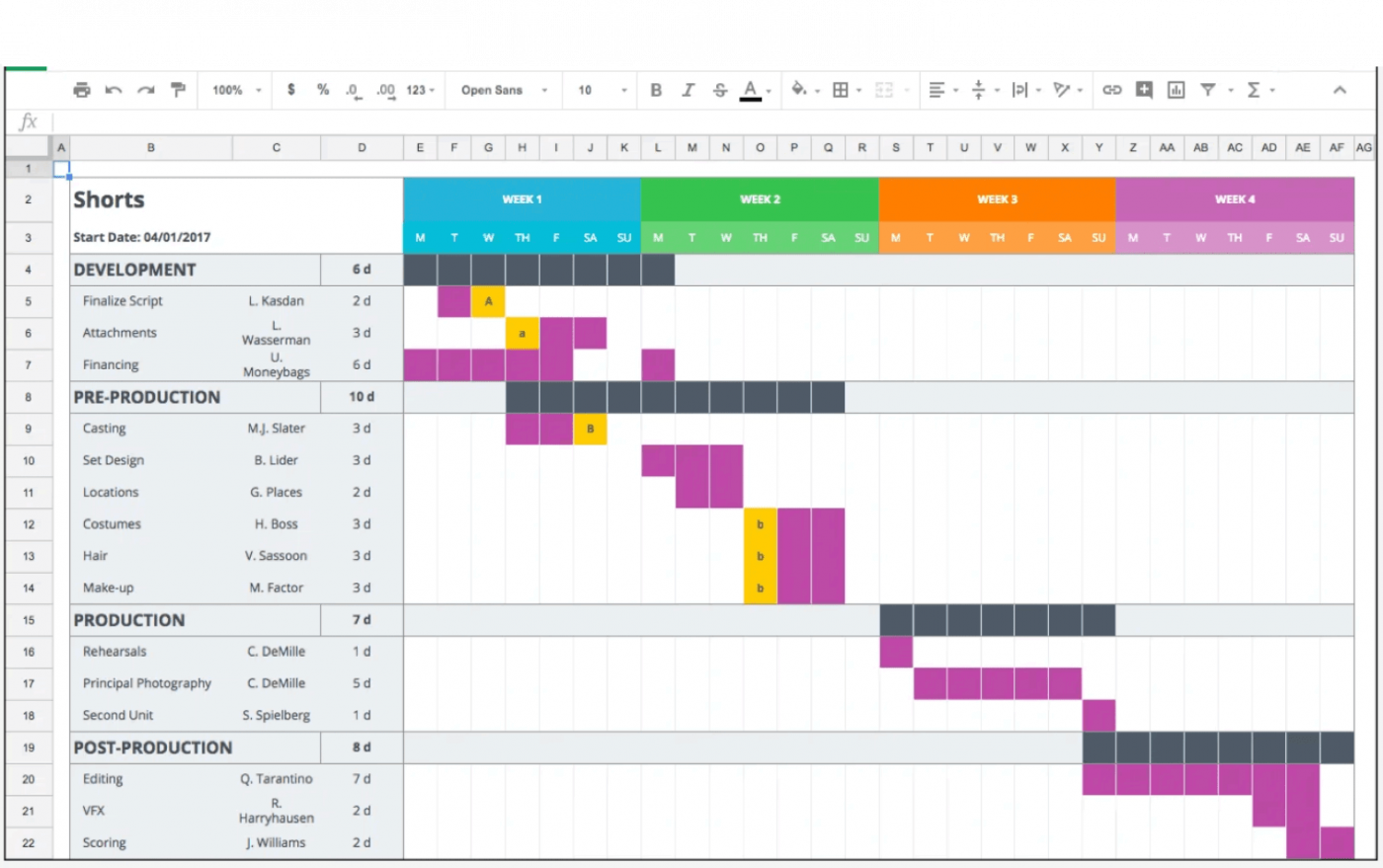
عبر Studiobinder
8. مثال على مخطط جانت لوسائل التواصل الاجتماعي
_وسائل التواصل الاجتماعي هي... أوكسجين العصر الحديث؟
الكثير منا يعيش ويتنفسه.
بل إن بعضنا قد بنى حياته المهنية حولها. ويتضمن ذلك تتبع منشورات وسائل التواصل الاجتماعي والمحتوى المشاركة وغير ذلك الكثير.
_ولكن كيف يمكنك القيام بكل ذلك دون الاستسلام لجنون التمرير؟
أنشئ مخططًا لوسائل التواصل الاجتماعي في مخطط جانت لتخطيط الحملات والتعاون مع فريق وسائل التواصل الاجتماعي والتأكد من النشر في الموعد المحدد.
يمكنك حتى التعاون مع فريقك لإنشاء جدول زمني كامل لوسائل التواصل الاجتماعي مع تفاصيل:
- ما يجب نشره
- موعد النشر
- مكان النشر
- من المسؤول عن النشر، إلخ.
_يجب أن تكون على أهبة الاستعداد إذا كنت تريد أن تخترق الإنترنت، أليس كذلك؟
إليك مثال على ذلك
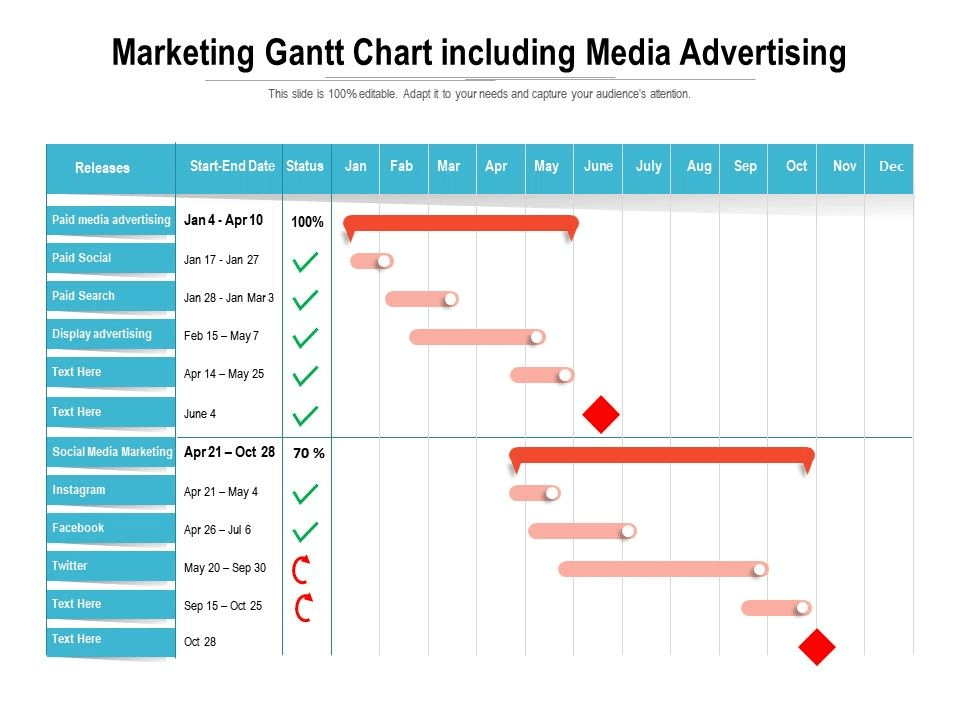
عبر فريق الشرائح
9. مثال على مخطط جانت لتخطيط الأحداث
لدى منظمي الفعاليات الكثير من التفاصيل التي يجب التوفيق بينها لضمان سير الفعاليات بسلاسة.
_وبمجرد ارتفاع مبيعات التذاكر؟
تحتاج إلى كل المساعدة التي يمكنك الحصول عليها.
وهنا يأتي دور مخططات جانت. استخدمها لتقسيم خطة الحدث في جميع التفاصيل الدقيقة. يمكنك حتى تجميع المهام حسب مرحلة التخطيط أو البائع.
حقيقة ممتعة: يمكنك حتى الترويج لفعاليتك باستخدام مخطط جانت.
قم بإنشاء استراتيجية ترويجية و جدولة المهام على الجدول الزمني لإنشاء كل الدعاية التي تحتاجها لحدث الإطلاق الخاص بك.
اجعل الناس يحضرون إلى المكان الذي ناضلت من أجله!
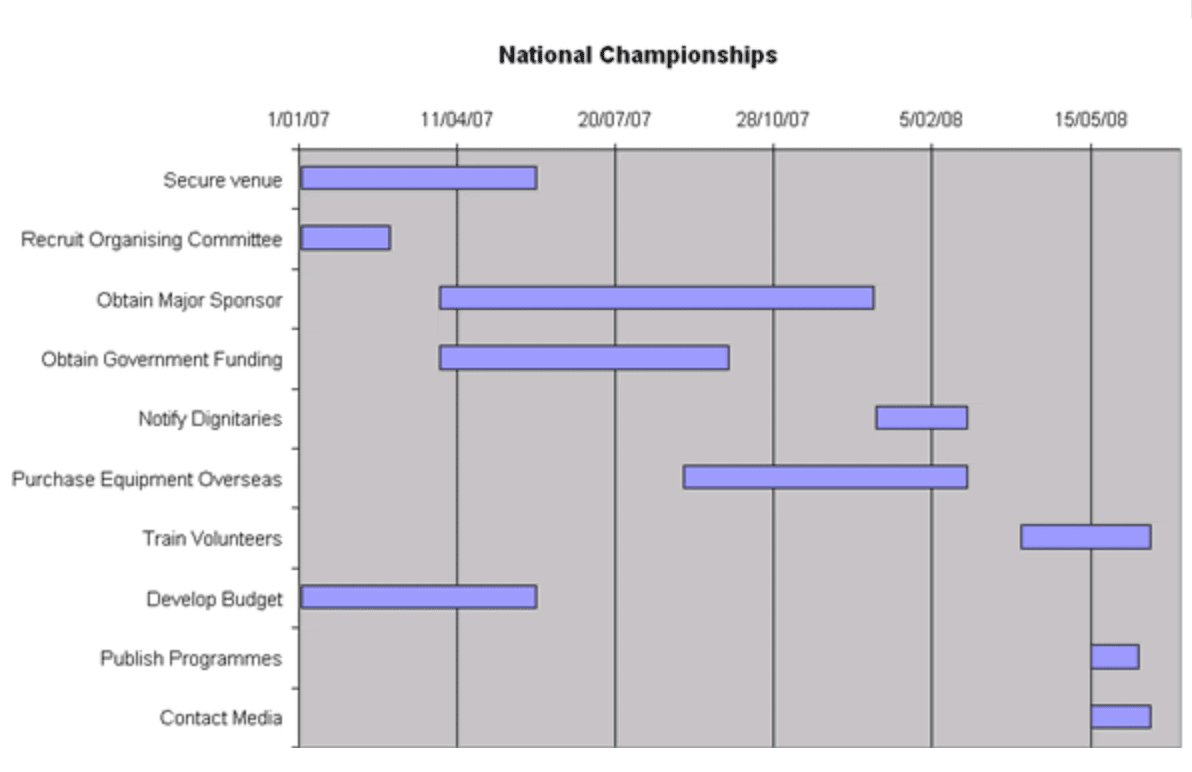
عبر ليو إسحاق
10. مثال على مخطط جانت للاستشاريين
لنأخذ مثالاً: قام عميلك بتعيينك لمساعدته في تحقيق أهدافه.
ومع ذلك، فهم عملاء جدد ويحتاجون إلى مزيد من الطمأنينة منك (الاستشاري) فيما يتعلق بالتقدم المحرز.
لا تقلق.
يمكنك أن تُظهر لعميلك أن لديك خارطة طريق عملية للنجاح من خلال مخطط جانت.
قسّم جميع المهام بين فريقك وفريق العميل. يمكنك أيضًا الرجوع إلى المخطط أثناء الاجتماعات الأسبوعية مع العميل للتأكد من أن كلاكما يغني نفس الأغنية.
مكافأة:_ برنامج تتبع الوقت للاستشاريين
11. مثال على مخطط جانت لمشاريع التصميم
متفاجئ لرؤية هذا في _ مثال على مخطط جانت البياني _؟
حسنًا، يمكن للمصممين والفرق استخدام مخططات جانت أيضًا.
من التصميم من التخطيط والرسم إلى الموافقة على التصميمات النهائية وعرضها للعالم، يمكن أن تكون مخططات جانت مفيدة في جميع مراحل سير عمل التصميم. يمكنك أيضًا التخطيط بسهولة لإطلاق التصميم وتتبع الحجوزات.
ومن يدري، قد تصل بك طريقة جانت إلى مدرج ميلانو.
إليك مثال على مخطط جانت لمشروع التصميم العام:

عبر الرسم الذكي تفقد هذه بدائل السحب الذكي !
12. مثال على مخطط جانت لتطوير تطبيقات الهاتف المحمول
سواء كنت شركة تقوم بإنشاء تطبيقات للهواتف المحمولة أو شركة تقوم بتطوير تطبيقات للآخرين، يمكن أن يكون مخطط جانت هو الحل الأمثل لك.
استخدمه لتخطيط وتصور الخطوات في عملية التطوير. يمكن أن يتضمن كل شيء بدءًا من تصميم مظهر التطبيق إلى ميزاته مثل:
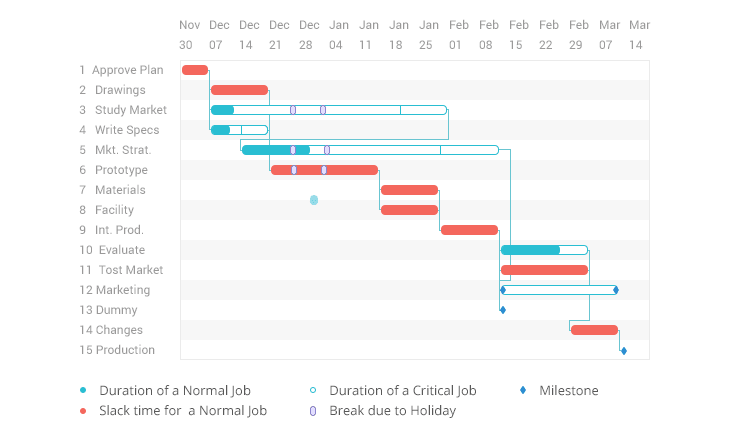
نظرًا لأنه سيتعين عليك العمل مع أشخاص وأقسام مختلفة وغير ذلك، يمكن لمخططات جانت أن تحسن فرصك في إنجاز العمل بشكل صحيح وبسرعة أكبر.
_إطلاق ناجح، ها نحن قادمون! ماركوس إسياس ، مدير مشروع معتمد من PMP في كلارو حول استخدام مخططات جانت في تطوير تطبيقات الأجهزة المحمولة:
"من خلال إجراء تمرين تعاوني على مخطط جانت مع الفريق، غالبًا ما نكتشف المهام غير المرئية وعمليات التحقق من الصحة المفقودة للحصول على تطبيق ناجح وعالي الجودة.
وقد ساعدنا ذلك في تحديد المهام الخفية التي كانت ستتسبب في حدوث تأخيرات إذا لم يتم تخطيطها بشكل صحيح. على سبيل المثال، غالبًا ما نخطط في كثير من الأحيان لضمان الجودة للبرنامج ولكن ربما [ننسى القيام بنفس الشيء] للخوادم التي ستحتفظ به. "
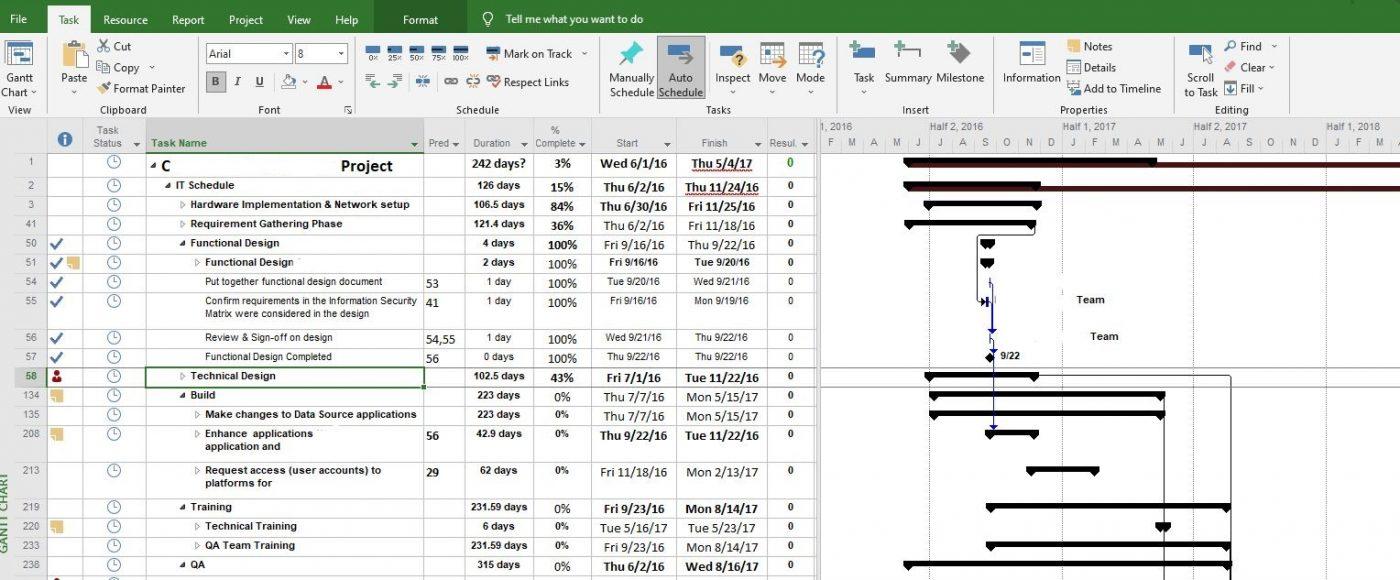
المصدر: ماركوس إسياس، PMP
13. مثال على مخطط جانت للتسويق عبر البريد الإلكتروني
_ لماذا فشلت حملة التسويق عبر البريد الإلكتروني للشبح؟
يمكنك أن ترى من خلاله
لا تخدع حملاتك التسويقية عبر البريد الإلكتروني. خطط لها ونفذها باستخدام مخططات جانت.
تتبع أشياء مثل التواريخ والأوقات وجهات الاتصال والموضوعات وما إلى ذلك.
يمكنك إدارة كل ما يتعلق برسائلك الإلكترونية وجهات الاتصال والعملاء المحتملين على مخطط واحد، حتى لا تفوت فرص المبيعات ولا تضيع الوقت.
14. مثال على مخطط جانت لتطوير البرمجيات
عندما يتعلق الأمر بـ
تطوير البرمجيات
فإن مخطط جانت يشبه قاطع الكعك. يمكن أن يساعدك على تصور مشروعك من خلال تقطيعه إلى مراحل عمل أصغر يمكنك إدارتها بسهولة .
يمكنك تتبع:
- أنشطة إدارة المشروع
- البدء أو التخطيط
- العصف الذهني للتصميم
- التطوير
- تحليل الجودة
- التشغيل والصيانة
وهذا ليس كل شيء. مخططات جانت مثالية أيضًا لتتبع الأخطاء البرمجية . 🐛
يتيح مخطط جانت لفريقك إرسال تقارير الأخطاء وتتبع المشكلات بينما يتوصل المطورون إلى حل المشكلات بسرعة. يمكنك حتى تعيين الأولويات حتى يعرف الجميع الأخطاء التي يجب إزالتها أولاً.
إليك مثال على نموذج لمخطط جانت لتطوير البرمجيات:

15. مثال على مخطط جانت البياني لإعداد الموظفين
مع الموظفين المعينين حديثًا، قد يكون من الصعب تتبع ما يحتاجون إلى معرفته والتدريب الذي أكملوه بالفعل.
لحسن الحظ، يمكن أن يساعدك مخطط جانت.
قم بإنشاء أقسام ومهام لكل موظف جديد وتأكد من مراجعة كل مهمة معهم. بهذه الطريقة، يمكنك التأكد من أن كل موظف جديد يتناسب مع الفريق بسهولة.
16. مثال على مخطط جانت للتسويق الرقمي
إذا كنت تريد أن يجدك الناس - خاصةً الأشخاص المناسبين - فيجب أن يكون التسويق الرقمي على رأس أولوياتك. يمكن أن يكون الإعلان من خلال وسائل التواصل الاجتماعي، وتحسين محركات البحث، والتسويق عبر البريد الإلكتروني، وما إلى ذلك.
باستخدام مخطط جانت، يمكنك رسم تاريخ البدء وتاريخ الانتهاء والميزانيات والمهام والمهام والمهام الفرعية لجميع استراتيجيات التسويق الرقمي الخاصة بك.
إليك نموذج مخطط جانت:

عبر كريتلي مكافأة: تحقق من هذا دليل حول إدارة مشاريع التسويق !
17. مثال على مخطط جانت التعليمي
هل تتذكر عندما كان التعليم يتمحور حول الفصول الدراسية والمكتبات والألواح البيضاء والاستعدادات للامتحانات في اللحظة الأخيرة؟
حسنًا، لا يزال معظم ذلك قائمًا، باستثناء أن الرقمنة قد استحوذت على كل ذلك.
فالألواح البيضاء أصبحت رقمية، والمكتبات على بعد بحث على جوجل، والتخطيط للفصل الدراسي يتم على مخططات جانت.
يمكن للمعلمين والطلاب تتبع الفصول الدراسية والبرامج ومواعيد الامتحانات عليها.
نصيحة احترافية لمعلمي التاريخ: مخططات جانت مثالية للتمثيل المرئي للجدول الزمني للأحداث التاريخية.
تعلم علم مخططات جانت البيانية واستعد لصنع التاريخ هذا العام الدراسي!
اصنع مخطط جانت التعليمي الخاص بك على ClickUp و تحقق من النماذج الخاصة بنا للطلاب !
18. مثال على مخطط جانت للمبيعات
إذا كنت على فريق المبيعات يجب أن تعرف
- ما يتم بيعه
- ما الذي لا يبيع
- من الذي يحقق مبيعات كبيرة
- من الذي لا يحقق أهداف المبيعات
وغير ذلك الكثير.
إذا لم تتابع هذه الجوانب، فإنك تخاطر بفقدان أرباح كبيرة.
لا تقلق؛ يضمن لك مخطط جانت عدم تفويت مثل هذه الفرص لجني الأموال. يمكنك تتبع جميع المبيعات، وجهات الاتصال، والعملاء المحتملين، وإعداد العملاء، وتقدم الصفقات، وما إلى ذلك.

عبر فريق الشرائح لا شيء ينزلق من خلال الشقوق لأن المخطط يحتوي على كل ما تحتاج إلى معرفته.
الآن كل ما عليك أن تقلق بشأنه هو انتظار اتصال العميل المحتمل بك.
(عذرًا، حتى مخططات جانت لا يمكنها مساعدتك في ذلك)
مكافأة:_
_/مرجع/ /مدونة؟ ص=42483 _أمثلة على المخطط البياني لـ RACI *%/%href/_
!
19. مثال على مخطط جانت المالي
بالتأكيد، قد يجعل المال العالم يدور. ولكن لا ينبغي أن يدور رأسك.
ولهذا السبب تستخدم العديد من المؤسسات المالية والبنوك مخططات جانت البيانية.
ويُعد مدير البنك مثالاً جيدًا على شخص يمكنه تتبع مهامه وخططه وخدمة العملاء وأداء الفريق وما إلى ذلك على مخطط جانت.
يمكن أن يساعد أيضًا في إعداد منتجات مصرفية جديدة مثل القروض والودائع وبطاقات الائتمان. كما أنه أداة رائعة لإدارة الحملات التسويقية في البنوك.
إليك مثالاً على ذلك:

عبر إنفستوبيديا
20. مثال على مخطط جانت لإدارة المحتوى
إذا كنت تعمل في فريق ينشر دفقًا ثابتًا من المحتوى، فإن المواعيد النهائية دائمًا ما تكون في انتظارك. مثل الجرو عندما يسمعك تفتح كيس رقائق البطاطس. ولكن أقل روعة. 😞
مع مخططات جانت، تكون مستعدًا دائمًا للمواعيد النهائية. استخدمها كتقويم تحريري لمعرفة ما هو قادم في الجدول الزمني.
يمكنك تنظيم مجموعات مهام محددة حسب الشهر والمقالة، وتعيين المعالم الرئيسية لتتبع الموافقات النهائية وتواريخ "بدء التشغيل".
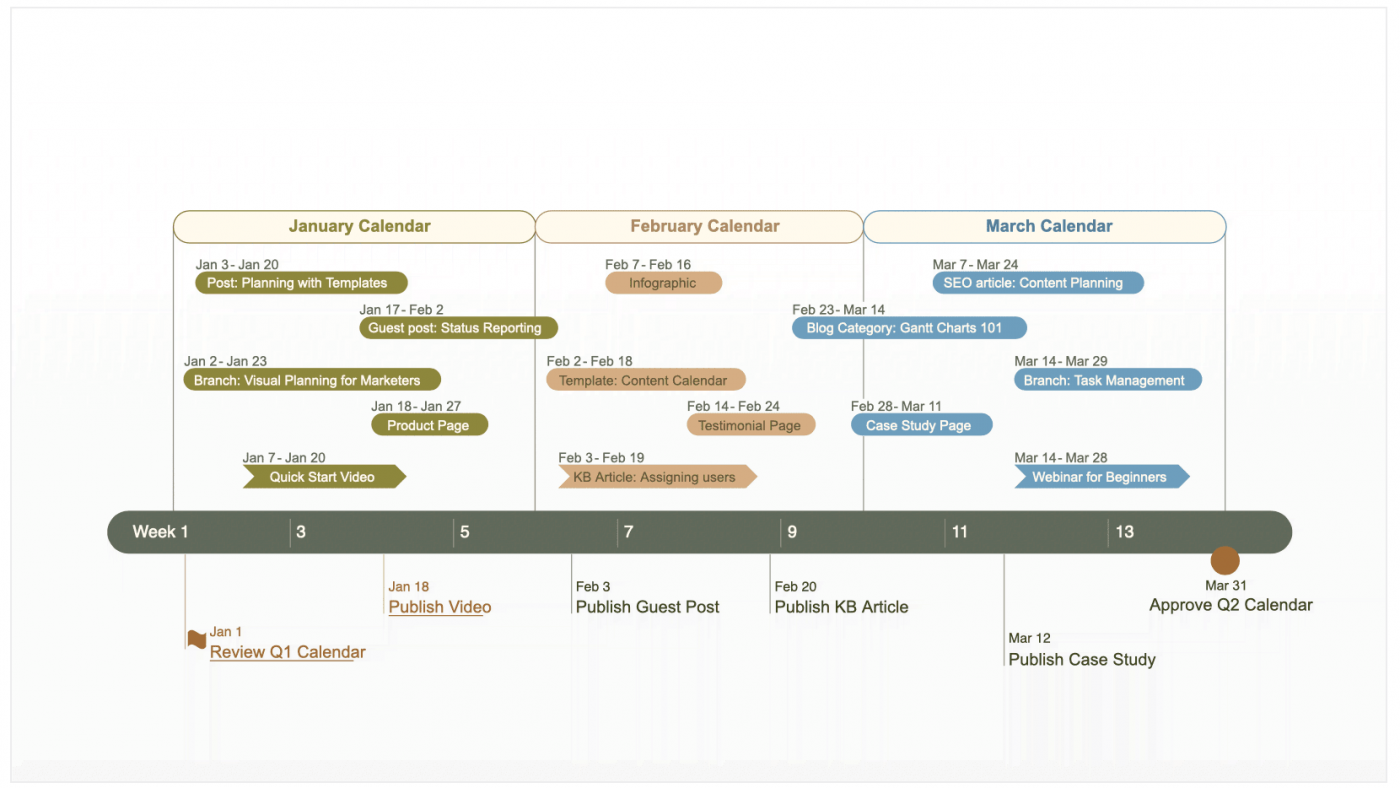
3 فوائد رئيسية لمخططات جانت في إدارة المشروعات
1. الحصول على نظرة عامة كاملة على مشروعك
هل تعرف ذلك الشعور المزعج عندما تجلس للعمل ولكنك تعتقد أنك نسيت شيئًا ما؟
يمكنك تجنب مثل هذا الشعور مع وجود مخطط جانت بين يديك. فهو يُظهر لك كل شيء في خطة مشروعك في لمحة واحدة، حتى لا تشعر أبدًا بأنك نسيت أي شيء.
يشبه نوعًا ما قائمة مهام لمشاريع متعددة يتم تحديثها من تلقاء نفسها.
2. تتبع تقدم المشروع في الوقت الفعلي
يمكنك اليوم تتبع مشوارك في سيارة الأجرة وتوصيل الوجبات السريعة في الوقت الفعلي.
فلماذا لا تفعل الشيء نفسه بالنسبة لجدول مشروعك؟
مخطط جانت هو بمثابة جهاز تتبع جغرافي لمشروعك.
قم بتزويده بمعلومات عن أنشطة المشروع، وقم بتحديثه عدة مرات، ثم ينطلق من تلقاء نفسه.
في الواقع، يأخذ مخطط جانت خطوة أخرى إلى الأمام من خلال إخبارك بـ المسار الحرج لجدول مشروعك. هذا هو الحد الأدنى من مجموعة المهام التي ستحتاج إلى إكمالها للوفاء بالموعد النهائي لمشروعك.
3. الحفاظ على شفافية المشروع
كان مخطط جانت في الأصل أداة لإدارة المشاريع يستخدمها المديرون لاتخاذ قرارات رفيعة المستوى.
ومع ذلك، تعد مخططات جانت الحديثة أداة أساسية لـ جميع أعضاء فريق المشروع.
يمكن لمديري المشاريع تحديث مخطط جانت ومشاركته بشكل روتيني مع فريق المشروع. يتيح ذلك لكل عضو رؤية كيفية عملهم معًا لتحقيق نفس النتائج.
وبعبارة أخرى، إنها الطريقة الأكثر موثوقية لإظهار الصورة الكبيرة للجميع ومساعدة الجميع على الشعور بالانسجام.
باختصار، فإن وجود مخطط جانت مخطط لإدارة مشروعك لا يقل أهمية عن حمل خريطة في رحلتك على الطريق.
كيفية إنشاء مخطط جانت
يمكنك إنشاء مخططات جانت في مايكروسوفت وورد , إكسل باور بوينت جداول بيانات جوجل والمزيد
ولكن إذا كنت لا تريد أن تصاب بالإحباط "من المستوى السفلي"، فعليك أن تفعل ما يفعله الأذكياء. إنشاء مخططات جانت باستخدام أداة إدارة المشاريع !
عادة، باستخدام هذه الأدوات، كل ما عليك فعله هو إنشاء قائمة مهام وإضافة تاريخ البدء وتاريخ الانتهاء. ثم تقوم الأداة بعد ذلك بعملها السحري لعرض مهام مشروعك مع مرور الوقت كمخططات جانت بديهية.
لكن ما الأداة التي يجب أن تستخدمها؟ استكشف الـ أفضل 13 برنامج مخطط جانت على الإنترنت للعثور على البرنامج المناسب._
لتوفير وقتك، سنقدم لك الإجابة هنا.
أداة مخطط جانت الوحيدة عبر الإنترنت التي تحتاجها هي ClickUp. إنها إحدى أدوات الإنتاجية الأعلى تقييمًا في العالم والتي تستخدمها فرق العمل في العديد من الشركات حول العالم.
ويمكنك إنشاء مخطط جانت بسيط (وجميل!) باستخدام طريقة عرض مخطط جانت البياني في ClickUp في ثلاث خطوات سهلة:
- انقر فوق علامة + في أي قائمة أو مجلد أو مساحة
- اختر جانت
- قم بتسميته
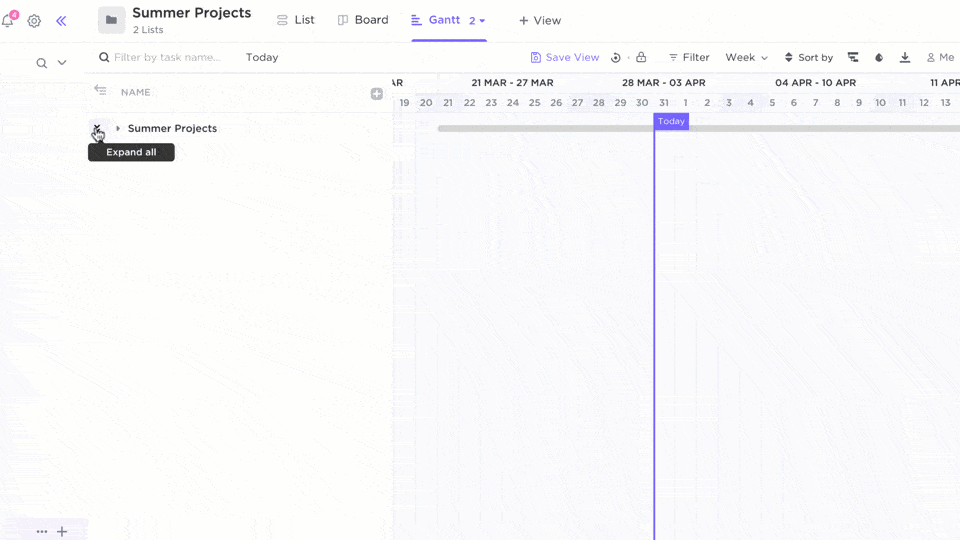
قم بتعديل ما تراه في مخططات جانت الخاصة بك باستخدام القائمة الجانبية القابلة للتوسيع والطي.
يمكنك استخدام المخطط لـ
- تخطيط الوقت وجدولة المهام
- إدارة الموارد
- تصور كل تبعية مهمة
- حسابالمسار الحرج وزمن التراخي
تحقق من هذه خيارات قالب قالب المخطط البياني !
## أمثلة على إدارة مشروع مخطط جانت البياني في ClickUp
الآن، هل أنت مقتنع بأن مخطط جانت مخطط جانت_ يشبه إلى حد كبير الإنترنت؟
يمكن أن يرتقي بأي مشروع أو صناعة أو فريق عمل إلى المستوى التالي.
يمكنك إنشاء واحد في PowerPoint، أو استخدام مخطط جانت في Excel أو حتى تنزيل قالب مخطط.
ولكن لا شيء يضاهي أداة ClickUp لصنع مخطط جانت المكونة من ثلاث خطوات.
باستخدام ClickUp، يمكنك تخصيصها لتناسب احتياجاتك، وإدارة الموارد، والتبعيات، وغير ذلك الكثير بكل سهولة. بالإضافة إلى ذلك، هذا برنامج مخطط جانت يمكن أن يفعل أكثر من مجرد مخططات جانت فيمكنه أن يكون أداة تعقب الوقت، ومدير المهام، وصانع المخططات الانسيابية، وأداة التدقيق... فقط سمِّ ما شئت. انضم إلى ClickUp مجانًا لإنشاء مخططات جانت رائعة لأي مشروع، في أي مجال.


